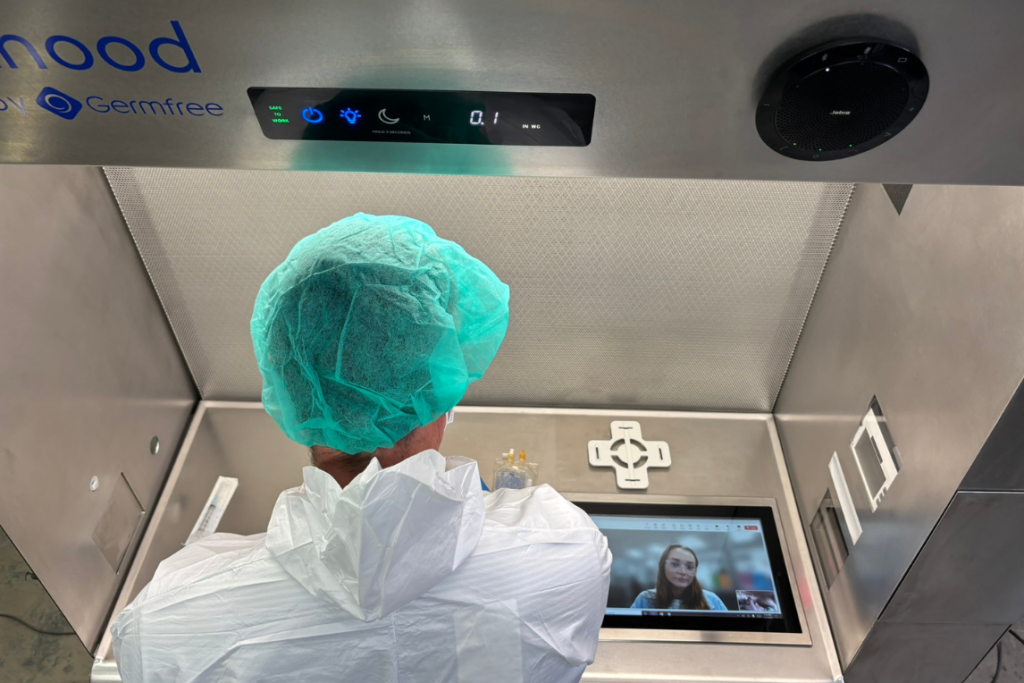Regulating the Shift: Quality and Compliance in Decentralized Drug Production
Industry:
Biopharma
Type:
Article
Technology is driving a fundamental shift in pharmaceutical and biotechnology manufacturing. For the first time, advanced mobile and modular platforms are making decentralized manufacturing truly viable, transforming how drugs are produced, delivered, and accessed. These platforms leverage automation, standardization, enhanced data throughput, and smart design to bring high-quality manufacturing closer to patients. Whether it’s cell and gene therapies (CGTs), intravenous (IV) medications, or essential generics, the ability to produce drugs near or at the point-of-care is no longer theoretical; it’s being tested and deployed today. But while the potential is immense, so are the challenges, particularly when it comes to maintaining quality oversight in decentralized environments.

The Stakes Are High
Nowhere is the promise of decentralization more urgent than in cell and gene therapy. Despite life-saving outcomes, commercialized autologous CGTs have struggled to reach patients due to logistical and cost barriers.
In some cases, advanced therapies have been withdrawn from the market not because of a lack of efficacy, but due to the limitations of the current infrastructure. A prominent example is Bluebird Bio’s withdrawal of Zynteglo and Skysona from the European market. Both therapies showed strong clinical outcomes but faced insurmountable challenges related to pricing, reimbursement, and the logistics of delivering autologous cell therapies through a centralized model. The infrastructure required to manufacture and distribute these therapies at scale simply wasn’t sustainable. Decentralized manufacturing offers a compelling alternative: by bringing production closer to the point of care, it is possible to reduce cost, eliminate complex logistics, and ultimately reach more patients who would otherwise be left behind.
Hospitals, too, face major pressure from drug shortages, often involving low-cost, high-utility drugs such as lidocaine or potassium chloride. A recent mobile cleanroom pilot project demonstrated that thousands of doses could be compounded near the hospital, safely and on demand, directly addressing this systemic issue.
Yet as decentralized models gain traction, the industry must rethink how quality is defined, maintained, and scaled across distributed networks.
Navigating the Challenges of Quality in Decentralized Systems
While decentralized manufacturing unlocks powerful new possibilities, greater flexibility, faster turnaround times, and local access to therapies, it also introduces a new set of complexities. Chief among these is the challenge of maintaining consistent quality across distributed networks.
In traditional, centralized manufacturing, Quality Assurance and Control (QA/QC) is tightly managed within a single facility. Dedicated teams oversee batch release, documentation, and compliance from start to finish, with robust controls in place to catch and correct deviations. But in a decentralized model, quality oversight becomes far more fragmented. QA/QC responsibilities may shift to geographically dispersed personnel or even downstream users of the manufacturing platform. Without a unified quality framework, these systems risk becoming bottom-heavy, overloaded with quality checks at the final stage, and lacking sufficient upstream process control.
The human element compounds the issue. Centralized manufacturing enables standardized training and certification programs, ensuring a uniform level of operator readiness. In contrast, mobile or point-of-care units may be staffed by individuals with varied backgrounds and levels of expertise. Without consistent training protocols and remote support tools, variability in execution becomes a very real concern, especially for sensitive products like autologous cell therapies, where the margin for error is incredibly narrow.
Adding to the complexity is the regulatory landscape. Decentralized operations often span multiple regions, each governed by different regulatory frameworks. This requires manufacturers to implement systems that not only ensure product quality, but also support real-time oversight, secure data sharing, and audit readiness across all locations.
Fortunately, the very technologies enabling decentralized manufacturing are also driving innovative solutions in quality assurance.
One successful model can be found in the evolution of IV drug compounding in hospitals. Following high-profile quality failures in past decades, the industry responded with tighter standards and the development of integrated compounding hoods. These systems bring together digital documentation, barcoding, volumetric imaging, gravimetric verification, robotics, and remote monitoring. By standardizing workflows and providing remote audit capabilities, hospitals can now ensure consistency across large health systems, even in physically dispersed sites.
This same approach is being replicated in the broader manufacturing space. In a recent pilot program, more than 12,000 doses of essential medications were manufactured in a mobile modular cleanroom stationed outside a hospital. Over six months, this unit demonstrated that decentralized, compliant production can be both repeatable and reliable. Leveraging real-time data monitoring and a “medication as-a-service” model, the project showcased what’s possible when infrastructure, technology, and quality oversight come together in a unified platform.
Looking ahead, Industry 4.0 technologies are poised to take decentralized quality management even further. Today’s next-generation CGT platforms are already incorporating:
- AI-powered predictive quality assurance to detect deviations before they impact product quality.
- Machine learning to continuously optimize manufacturing processes.
- Centralized remote QA dashboards to manage multiple sites simultaneously.
- Predictive maintenance systems are used to prevent equipment failures before they occur.
Together, these innovations create a digitally connected quality ecosystem capable of maintaining the highest standards while scaling across networks of decentralized manufacturing units. With the right strategy and tools, manufacturers can confidently extend their footprint without compromising the safety, efficacy, or reliability of the therapies they produce.

A Shift in Regulatory Thinking: FDA Lays the Groundwork for Decentralized Manufacturing
In recent years, the U.S. Food and Drug Administration (FDA) has taken deliberate steps to modernize its regulatory framework, signaling growing alignment between regulatory expectations and the realities of decentralized and digitally enabled pharmaceutical manufacturing. Two key publications, the 2022 FDA discussion paper on Distributed and Point-of-Care Manufacturing and the January 2025, “Considerations for Complying With 21 CFR 211.110: Guidance for Industry,” demonstrate how the agency is laying the groundwork for a future where drug manufacturing can occur closer to the patient while maintaining compliance, quality, and control.
The 2022 discussion paper, “Distributed Manufacturing and Point-of Care Manufacturing of Drugs” (FDA, 2022), was one of the first formal acknowledgments that manufacturing models based on modular, mobile, or point-of-care systems may be essential for expanding access, addressing drug shortages, and increasing supply chain resilience. In it, the FDA introduced the concept of a distributed manufacturing system operating under centralized quality oversight, enabled by standardized equipment, digital infrastructure, and real-time data sharing. It also recognized the need for regulatory adaptability to accommodate this new paradigm.
Building on that conceptual foundation, the FDA’s January 2025 guidance, “Considerations for Complying With 21 CFR 211.110: Guidance for Industry” (FDA, 2025) offers a more detailed and practical regulatory mechanism to support this vision. The document outlines how manufacturers, particularly those adopting advanced manufacturing technologies such as continuous manufacturing or 3D printing, can meet the requirements for in-process controls under 21 CFR § 211.110.
The guidance supports the use of process models, real-time quality monitoring, and innovative sampling strategies to ensure drug product integrity and batch uniformity. It explicitly encourages scientific and risk-based justification for determining where, when, and how in-process controls should be applied, marking a major step toward regulatory flexibility. While the FDA notes that current process models alone may not yet be sufficient to replace physical testing in all cases, it strongly supports their use as part of a hybrid control strategy that includes in-line monitoring and surrogate measurements.
Manufacturers are also encouraged to engage early with the FDA’s Emerging Technology and Advanced Technologies Teams to explore novel control strategies, a clear indication that the agency is seeking to enable innovation through proactive collaboration.
Taken together, these two documents represent a converging regulatory vision. The 2022 discussion paper lays out the growing importance of decentralized models in addressing public health needs. The 2025 guidance outlines how a flexible, science-driven approach to implementing in-process control strategies that are compatible with decentralized, digitally connected systems.
With this evolving regulatory foundation, decentralized manufacturing is no longer a conceptual ambition; it is becoming a practical, supported pathway to improve patient access and supply chain resilience while upholding the highest standards of product quality.
MHRA’s 2024 Guidance on Modular and Point-of-Care Manufacture
The UK’s Medicines and Healthcare products Regulatory Agency (MHRA) has taken a bold step by issuing new guidance specifically tailored to modular and point-of-care (POC) manufacturing of ATMPs.
In a landmark move to modernize pharmaceutical oversight, the UK’s Medicines and Healthcare products Regulatory Agency (MHRA) enacted The Human Medicines (Amendment) (Modular Manufacture and Point of Care) Regulations 2025 on January 23, 2025. These new regulations formally recognize modular and point-of-care (POC) manufacturing as legitimate pathways to produce medicinal products, including advanced therapy medicinal products (ATMPs). This marks one of the most significant steps globally in adapting regulatory frameworks to enable decentralized and patient-proximal manufacturing.
Under the new framework, the MHRA has introduced two distinct manufacturing licenses: a Manufacturer’s License (MM) for modular manufacture and a Manufacturer’s License (POC) for point-of-care manufacture. These licenses come with the requirement to maintain a master file – either MM or POC – which details the manufacturing process, product scope, quality controls, site supervision protocols, and pharmacovigilance arrangements. Each product must have its dedicated master file, and manufacturing operations must be overseen by a central control site, regardless of where physical production occurs.
Importantly, the regulation allows manufacturers to manage distributed operations under a single license, with the ability to amend master files to add new products or sites without initiating a full variation process – thus supporting scalability and responsiveness. This flexibility is essential for the deployment of mobile cleanrooms and for the delivery of short-shelf-life or highly personalized therapies directly at or near the patient.
The MHRA’s approach maintains full adherence to existing GMP principles while enabling innovative control strategies tailored to decentralized environments. The new rules also integrate pharmacovigilance requirements to ensure traceability and safety monitoring at every site where a product is administered.
Overall, the MHRA’s framework is among the most forward-thinking in the world. It not only supports innovation but also sets a clear and practical pathway to regulatory compliance for emerging decentralized CGT platforms. In doing so, it lays the groundwork for international regulatory alignment, with agencies like the FDA and EMA expected to follow suit as the sector evolves.
Conclusion: A Quality-First Future
Decentralized manufacturing is poised to revolutionize the way drugs are made and delivered, but it will only succeed if quality systems evolve alongside the technology.
The way forward includes:
- Investing in standardized, integrated platforms
- Leveraging real-time monitoring, automation, and AI
- Aligning with progressive regulatory frameworks (MHRA, FDA, ICH)
- Building training, compliance, and oversight into every layer of decentralized operations
With the right collaboration between innovators, manufacturers, and regulators, decentralized manufacturing can deliver on its promise: safe, effective, affordable therapies produced when and where patients need them most.
References
- U.S. Food and Drug Administration. (2022). Distributed Manufacturing and Point-of-Care Manufacturing of Drugs: Discussion Paper. Retrieved from https://www.fda.gov/ media/162157/download
- U.S. Food and Drug Administration. (2025). Considerations for Complying With 21 CFR 211.110: Guidance for Industry (Draft). Retrieved from https://www.fda.gov/ media/184825/download
- The Human Medicines (Amendment) (Modular Manufacture and Point of Care) Regulations 2025. UK Statutory Instruments. Published January 23, 2025. Available at: https://www. legislation.gov.uk/uksi/2025/93/made
You might also be interested in

Why Mobile and Modular Cleanrooms are Changing the Game in Bio-Manufacturing

Smarthood™: Setting a New Standard in IV Compounding

Smarter Containment: How AI is Reshaping Aseptic Environments
Contact us: Let's unlock your scientific potential together
Complete our contact form and a member of our commercial team will contact you within 24 hours.
